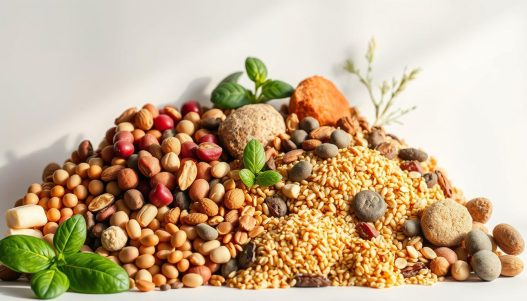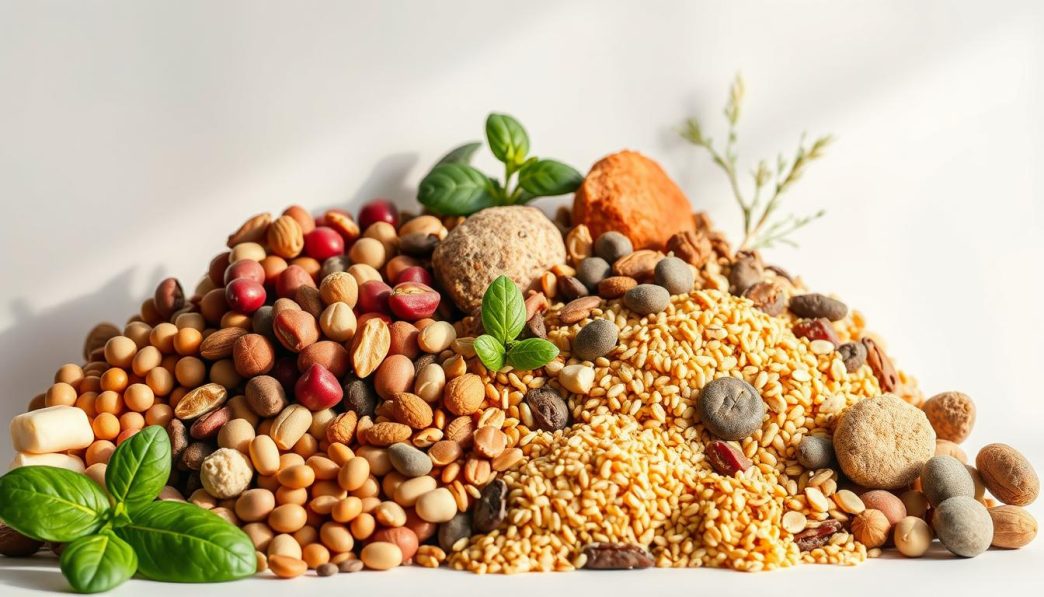As more people turn to plant-based diets, the demand for diverse and innovative protein sources is on the rise. While tofu is a well-known option, there’s a whole world of alternative plant-based protein sources waiting to be explored.
The shift towards vegan protein and alternative protein sources is driven by a desire for healthier and more sustainable eating habits. This trend is not just about replacing traditional protein sources but about discovering new flavors and textures that can enhance any meal.
Key Takeaways
- Discover new plant-based protein sources beyond the usual suspects.
- Explore the benefits of incorporating vegan protein into your diet.
- Learn about the growing trend of alternative protein sources.
- Find innovative ways to add plant-based protein to your meals.
- Understand the importance of diverse protein sources in a balanced diet.
The Rising Popularity of Plant-Based Diets
The shift towards plant-based diets has been gaining momentum globally, driven by increasing awareness of their health and environmental benefits. As people become more conscious of their dietary choices, the appeal of plant-based eating continues to grow.
Health Benefits of Plant-Based Eating
Adopting a plant-based diet can lead to numerous health benefits, including reduced risk of chronic diseases such as heart disease, diabetes, and certain cancers. Plant-based diets are typically rich in fiber, vitamins, and minerals, which are essential for maintaining overall health. By focusing on whole, minimally processed foods, individuals can significantly improve their nutritional intake.
Environmental Impact of Plant-Based Choices
The environmental benefits of plant-based diets are substantial. Animal agriculture is a significant contributor to greenhouse gas emissions, deforestation, and water pollution. By choosing plant-based options, individuals can reduce their carbon footprint and support more sustainable agricultural practices. This shift in dietary preference can play a crucial role in promoting environmental sustainability.
Incorporating more plant-based meals into one’s diet is a practical step towards sustainable eating. As consumers become more informed about the environmental impact of their food choices, the demand for plant-based products continues to rise, driving innovation in the food industry.
Why Protein Diversity Matters in Plant-Based Diets
The importance of protein diversity in plant-based diets cannot be overstated, as it provides a broad range of essential amino acids. A diverse protein intake ensures that individuals get all the necessary building blocks for optimal health.
Complete vs. Incomplete Proteins
Proteins are classified as complete or incomplete based on their amino acid profiles. Complete proteins contain all nine essential amino acids that the human body cannot produce on its own. Most plant-based proteins are considered incomplete, but this doesn’t mean they can’t provide all the necessary amino acids when consumed in variety.
For example, grains like rice and wheat are low in lysine, while legumes are high in lysine but may be low in methionine. By combining these protein sources, individuals can ensure they are getting a complete amino acid profile.
Amino Acid Profiles and Their Importance
Amino acids are the fundamental components of proteins, and their profiles vary across different plant-based foods. Understanding the amino acid profiles of various protein sources can help individuals plan their diets more effectively. For instance, nuts and seeds are not only good sources of protein but also provide healthy fats and fiber.
Breaking the Protein Myth
A common myth surrounding plant-based protein is that it’s difficult to get enough protein without consuming animal products. However, with a little planning and knowledge of protein-rich plant foods, it’s entirely possible to meet daily protein needs. Legumes, nuts, seeds, and whole grains are all high in protein and can be easily incorporated into a variety of meals.
By understanding the principles of protein diversity and amino acid profiles, individuals can confidently adopt a plant-based diet that is both nutritious and satisfying.
Plant-Based Protein Sources Beyond Tofu
The world of plant-based proteins extends far beyond tofu, offering a variety of nutritional benefits. As individuals explore alternative protein sources, they can discover a range of options that not only provide essential amino acids but also offer diverse culinary experiences.
Overview of Alternative Options
Beyond tofu, some of the most notable plant-based protein sources include legumes, nuts, seeds, and whole grains. Legumes such as lentils, chickpeas, and black beans are not only rich in protein but also in fiber and essential minerals. Nuts and seeds, including almonds, chia seeds, and hemp seeds, offer a crunchy texture and a boost of healthy fats alongside protein.
Protein Content Comparison
Comparing the protein content of various plant-based sources can help individuals plan their diets effectively. The following table outlines the protein content of some key sources:
| Food Item | Serving Size | Protein Content (grams) |
|---|---|---|
| Lentils | 1 cup cooked | 18 |
| Chickpeas | 1 cup cooked | 15 |
| Almonds | 1 ounce | 6 |
| Chia Seeds | 1 ounce | 5 |
| Hemp Seeds | 1 ounce | 10 |
Bioavailability Considerations
Bioavailability refers to the body’s ability to absorb and utilize the protein from different sources. While some plant-based proteins have lower bioavailability compared to animal-derived proteins, combining various sources can enhance overall protein absorption. For instance, pairing whole grains with legumes can provide a complete amino acid profile.
In conclusion, exploring plant-based protein sources beyond tofu not only diversifies one’s diet but also ensures a broad intake of essential nutrients. By understanding the protein content and bioavailability of different sources, individuals can make informed choices about their nutritional needs.
Legumes: The Protein Powerhouses
Among the most significant plant-based protein sources are legumes, which include a variety of beans, lentils, and peas. These nutritional powerhouses have been a staple in diets around the world for centuries, providing not only protein but also fiber, vitamins, and minerals.
Beans, Lentils, and Chickpeas
Common legumes like kidney beans, black beans, lentils, and chickpeas are well-known for their protein content. For example, a single cup of cooked lentils provides about 18 grams of protein. These foods are versatile and can be incorporated into a variety of dishes, from soups to salads.
Lesser-Known Legumes Worth Trying
Beyond the familiar options, there are numerous lesser-known legumes worth exploring, such as aduki beans, mung beans, and lablab beans. These can add variety to your diet and offer unique nutritional profiles.
Preparation Methods to Maximize Nutrition
To maximize the nutritional benefits of legumes, proper preparation is key. This includes soaking and cooking them appropriately to reduce phytic acid and enhance digestibility. Some legumes can also be sprouted to increase their nutritional value.
By incorporating a variety of legumes into your diet, you can significantly boost your protein intake while enjoying a range of other health benefits.
Seitan: The Wheat Meat Revolution
Seitan, a meat substitute derived from wheat gluten, is changing the face of plant-based eating. This versatile food has been a staple in Asian cuisine for centuries and is now gaining popularity worldwide.
What Is Seitan and How It’s Made
Seitan is made by washing wheat flour dough with water to remove the starch, leaving behind the gluten. The resulting product is chewy and meat-like, making it a popular choice among vegetarians and vegans.
Nutritional Profile and Cooking Applications
Seitan is high in protein and low in fat, making it an attractive option for those looking to increase their protein intake. It can be marinated, baked, or stir-fried and is often used in place of meat in dishes like stir-fries and stews.
Gluten Concerns and Alternatives
While seitan is a great option for those looking for a meat substitute, it’s not suitable for individuals with gluten intolerance or sensitivity. Alternatives like tofu and tempeh can be used instead.
| Nutritional Information (per 100g) | Seitan | Tofu |
|---|---|---|
| Protein | 21g | 8g |
| Fat | 1g | 4g |
| Carbohydrates | 10g | 2g |
Tempeh and Other Fermented Soy Products
Tempeh, a fermented soy product, has gained popularity for its nutritional benefits and versatility in cooking. It is part of a broader category of fermented soy products that are rich in protein and offer various health benefits.

Benefits of Fermentation for Protein Absorption
The process of fermentation significantly enhances the nutritional profile of soy products. Fermentation breaks down complex proteins into more easily absorbed amino acids, making tempeh a highly bioavailable protein source. This process also increases the availability of isoflavones, which are associated with various health benefits.
Research has shown that fermented soy products like tempeh can improve gut health, which in turn enhances protein absorption. A healthy gut microbiome is crucial for overall nutritional well-being, and consuming fermented foods can contribute to this balance.
Cooking with Tempeh and Natto
Cooking with tempeh is versatile and straightforward. It can be marinated, baked, or stir-fried, making it a great addition to various dishes. Natto, another fermented soy product, is known for its sticky texture and strong flavor. While it’s often consumed as is in Japan, it can also be incorporated into salads or mixed with rice.
- Marinate tempeh in a mixture of soy sauce, maple syrup, and garlic for a delicious stir-fry.
- Add crumbled tempeh to salads for a protein boost.
- Use natto in sushi rolls for a nutritious twist.
Addressing Soy Misconceptions
Despite its benefits, soy is often subject to misconceptions. Some believe that soy consumption is linked to hormone-related issues due to its isoflavone content. However, numerous studies have shown that moderate soy consumption is safe for most people. In fact, the isoflavones in soy products like tempeh may offer protective benefits against certain cancers and heart disease.
“The health benefits of soy foods are well-documented, and when consumed as part of a balanced diet, they can be a nutritious addition to one’s meal plan.”
| Fermented Soy Product | Protein Content | Culinary Uses |
|---|---|---|
| Tempeh | 15g per 3 oz serving | Stir-fries, salads, sandwiches |
| Natto | 18g per 3 oz serving | Sushi, salads, rice bowls |
| Miso | 2g per tablespoon | Soups, sauces, marinades |
Global Plant Protein Traditions
Exploring global cuisines reveals a diverse array of traditional plant protein sources. Different cultures have developed unique ways to incorporate protein-rich foods into their diets, often based on locally available ingredients and traditional cooking methods.
Asian Protein Sources Beyond Tofu
Asia is home to a wide variety of plant-based proteins. Seitan, made from wheat gluten, is a popular protein source in East Asian cuisine, particularly in Chinese and Japanese cooking. Other notable examples include mung beans and azuki beans, which are commonly used in both savory and sweet dishes.
Mediterranean Plant Protein Staples
The Mediterranean diet is renowned for its health benefits, partly due to its emphasis on plant-based proteins. Lentils and chickpeas are staples, often used in soups, stews, and salads. Additionally, fava beans are a traditional protein source in many Mediterranean countries.
Latin American Protein-Rich Foods
Latin American cuisine boasts a rich tradition of plant-based proteins. Quinoa, a complete protein, is a staple in the Andean region. Other protein-rich foods include amaranth and various types of beans, such as black beans and pinto beans.
These global plant protein traditions not only highlight the diversity of vegan and vegetarian diets but also offer inspiration for incorporating more plant-based proteins into our daily meals.
Seeds and Nuts as Protein Powerhouses
Seeds and nuts, often overlooked, are actually potent sources of protein in a plant-based diet. These small but mighty foods pack a significant nutritional punch, making them excellent additions to meals and snacks.
Hemp, Chia, and Flax Seeds
Hemp seeds are a complete protein source, containing all nine essential amino acids. Chia seeds are another protein-rich option, with about 5 grams of protein per ounce. Flax seeds offer a slightly lower protein content but are rich in omega-3 fatty acids and fiber.
Almonds, Walnuts, and Other Protein-Rich Nuts
Nuts like almonds and walnuts are not only delicious but also provide a good amount of protein. Almonds offer about 6 grams of protein per ounce, while walnuts provide around 4 grams. Other protein-rich nuts include pecans and pistachios.
Creative Ways to Include Seeds in Your Diet
Incorporating seeds into your diet can be easy and fun. Try adding chia seeds to your morning oatmeal or blending hemp seeds into your favorite smoothie. You can also sprinkle flax seeds on salads or yogurt for an extra nutritional boost.
By incorporating a variety of seeds and nuts into your diet, you can significantly enhance your protein intake and enjoy the numerous health benefits these foods offer.
Emerging Plant Protein Innovations
New frontiers in plant protein are opening up, offering exciting alternatives to traditional sources. As consumers increasingly demand more diverse and sustainable protein options, the industry is responding with innovative solutions.

Algae and Aquatic Protein Sources
Algae-based proteins are gaining attention for their high nutritional value and environmental sustainability. Algae are rich in protein and essential amino acids, making them a valuable source of plant-based protein. Aquatic plants and algae are being explored for their potential to provide protein-rich foods and supplements.
Lab-Cultivated Plant Proteins
Lab-cultivated proteins represent a cutting-edge innovation in plant-based nutrition. This technology involves producing protein through cell culture rather than traditional farming, offering a potentially more sustainable and consistent source of protein. Lab-cultivated proteins are poised to revolutionize the plant-based industry by providing high-quality protein with reduced environmental impact.
Future Trends in Plant-Based Nutrition
Looking ahead, the future of plant-based nutrition is likely to be shaped by continued innovation and consumer demand for sustainable, healthy, and diverse protein sources. Trends to watch include the development of new protein sources, advancements in food technology, and a growing focus on the environmental and social impact of food production. As the industry evolves, we can expect to see emerging plant protein sources becoming more mainstream.
The convergence of technology, consumer demand, and sustainability is driving the future of plant-based protein. As these trends continue to unfold, the possibilities for innovative and accessible plant protein sources are vast.
Plant-Based Protein Powders and Supplements
With the rise of plant-based eating, protein powders derived from plants have emerged as a convenient and effective way to boost protein intake. These supplements cater to various dietary needs and preferences, offering a versatile solution for individuals looking to enhance their nutrition.
Pea, Rice, and Hemp Protein Powders
Among the most popular plant-based protein powders are those made from peas, rice, and hemp. Pea protein is renowned for its high protein content and ease of digestion, making it an excellent choice for athletes and individuals with sensitive stomachs. Rice protein, on the other hand, is hypoallergenic and easy to digest, often recommended for those with dairy or soy allergies. Hemp protein is rich in essential fatty acids and offers a complete amino acid profile, making it a nutritious addition to any diet.
| Protein Type | Protein Content | Digestibility |
|---|---|---|
| Pea Protein | High | Easy |
| Rice Protein | Moderate | Easy |
| Hemp Protein | Moderate | Moderate |
How to Choose Quality Supplements
When selecting a plant-based protein powder, it’s crucial to consider factors such as the source of the protein, manufacturing processes, and additional ingredients. Look for products that are certified organic and free from common allergens if you have specific sensitivities. Reading labels carefully and researching the brand can help ensure you’re getting a high-quality supplement.
“The quality of your protein powder can significantly impact its effectiveness and your overall health. Always opt for products from reputable manufacturers that prioritize purity and potency.” – Nutrition Expert
Making Delicious Protein Smoothies
One of the most enjoyable ways to consume plant-based protein powders is by making delicious smoothies. Combine your preferred protein powder with fruits, vegetables, and a liquid base such as almond milk or coconut water. For example, a smoothie made with pea protein, banana, spinach, and almond milk offers a nutrient-packed start to your day.
- Choose a protein powder that complements your flavor preferences.
- Add fruits or vegetables for natural sweetness and extra nutrients.
- Experiment with different liquid bases to achieve your desired consistency.
By incorporating plant-based protein powders into your diet, you can easily meet your protein needs while enjoying the benefits of a plant-based lifestyle. Whether you’re an athlete, a busy professional, or simply someone looking to improve their nutrition, there’s a plant-based protein powder that’s right for you.
Practical Tips for Incorporating Alternative Proteins
Exploring alternative proteins can add variety to your meals and support a more sustainable food system. With so many options available, it’s easier than ever to incorporate these protein sources into your daily diet.
Simple Recipe Ideas and Meal Planning
Start by experimenting with simple recipes that feature alternative proteins as the main ingredient. Try making a hearty lentil soup or a chickpea salad with protein-rich ingredients.
Meal planning is also crucial for incorporating alternative proteins. Plan your meals around seasonal produce and protein sources like beans, lentils, or tempeh.
Protein-Rich Snack Options
Keep protein-rich snacks on hand, such as nuts, seeds, or energy balls made with nut butter and protein powder.
Other options include roasted chickpeas or edamame, which make for a satisfying and protein-packed snack.
Batch Cooking for Busy Lifestyles
Batch cooking is a lifesaver for busy lifestyles. Cook large batches of grains, beans, or lentils and use them throughout the week in different meals.
Time-Saving Preparation Techniques
Use a slow cooker or instant pot to prepare meals in advance. These techniques save time and ensure that your meals are ready when you need them.
Storage Tips for Maximum Freshness
Store cooked meals in airtight containers and keep them in the refrigerator for up to three days. Freeze meals like soups or stews for longer storage.
Conclusion
Exploring alternative plant-based protein sources is a crucial step towards a more inclusive and varied vegan lifestyle. By incorporating a range of options, individuals can ensure they are meeting their nutritional needs while enjoying the benefits of a plant-based diet.
The numerous alternatives to traditional protein sources like tofu offer a wealth of choices for those adopting a vegan lifestyle. From legumes and seitan to tempeh and other fermented soy products, the options are vast and varied.
By embracing these alternative proteins, individuals can not only enhance their nutritional intake but also discover new flavors and cuisines. Whether through global plant protein traditions or emerging innovations, the world of plant-based protein sources is rich and diverse.
As the demand for plant-based options continues to grow, it’s clear that a vegan lifestyle is not just a dietary choice but a pathway to a more sustainable and compassionate way of living.






